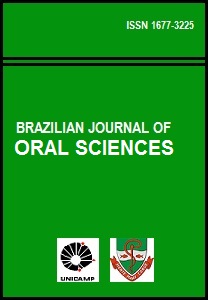Abstract
The present in vitro study was designed to evaluate the effect of high temperature firing cycles used for application of porcelain veneer in the misfit of implant supported frameworks, and the effect of a pre-heating treatment on the dimensional alterations of implant supported frameworks. The investigation was conducted based on the results given by 14 nickel-chromium (06 elements) metal structures. Half of the structures formed the control group and were exposed to simulated porcelain firings. The other half formed the test group, and were submitted to a pre-heating treatment with the implant frameworks embedded in investment, before the porcelain firing simulation. The marginal misfit measurements in both groups were made before and after the porcelain firing simulation, by using a scanning electron microscope. The results were submitted to statistical analysis of variance. The multiple comparisons were made by means of the Bonferroni “t” test. For the frameworks produced in the usual manner, without the preheating treatment (control group), misfit deteriorates during the high temperature firing cycles employed for porcelain application. In the test group, pre-heating treatment did not change the final metal distortion resulting from the porcelain firing cycles, and the greatest amount of the distortion took place before the conventional porcelain firing cycles.References
Adell R, Lekholm U, Rockler B, Branemark PI. A 15-year study of osseointegrated implants in the treatment of the edentulous jaw. Int J Oral Surg 1981 10 (6): 387-416.
Anusavice KJ, Carroll JE.. Effect of incompatibility stress on the fit of metal ceramic crowns. J Dent Res 1987; 66 (8): 1341-5.
Bridger DV, Nicholls JI. Distortion of ceramometal fixed partial dentures during the firing cycle. J Prosthet Dent 1981; 45: 507-14.
Bryant RA, Nicholls JI. Measurement of distortions in fixed dentures resulting from degassing. J Prosthet Dent 1979; 42: 515-20.
Burguete RL, Johns RB, King T, Patterson EA. Tightening characteristics for screwed joints in osseointegrated dental implants. J Prosthet Dent 1994; 71: 592-9.
Campbell SD, Pelletier LB. Thermal cycling distortion of metal ceramics: Part I - metal collar width. J Prosthet Dent 1992; 67: 603-8.
Campbell SD, Pelletier LB. Thermal cycling distortion of metal ceramics: Part II – etiology. J Prosthet Dent 1992; 68: 284-9.
Campbell SD, Sirakian A, Pelletier LB, Giordano RA. Effects of firing cycle and surface finishing on distortion of metal ceramic castings. J Prosthet Dent 1995; 74: 476-81.
Carr AB, Gerard DA, Larsen PE. The response of bone in primates around unloaded dental implants supporting prostheses with different levels of fit. J Prosthet Dent 1996; 76: 500-9.
De Hoff PH, Anusavice KJ. Effect of metal design on marginal distortion of metal-ceramic crowns. J Dent Res 1984; 63: 1327-31.
Gemalmaz D, Berksun S, Kasapoglu C, Alkumru HN. Distortion of metal-ceramic fixed partial dentures resulting from metalconditioning firing. Quintessence Int 1996; 27: 193-201.
Goll GE. Production of accurately fitting full-arch implant frameworks: Part I- clinical procedures. J Prosthet Dent 1991; 66: 377-84.
Guichet DL, Caputo AA, Choi H, Sorensen JA. Passivity of fit and marginal opening in screw-or cement-retained implant fixed partial denture designs. Int J Oral Maxillofac Implants 2000; 15: 239-46.
Hurson S. Practical clinical guidelines to prevent screw loosening. Int J Dent. Symp 1995; 3: 22-5.
Jemt T, Book K. Prosthesis misfit and marginal bone loss in edentulous implant patients. Int J Oral Maxillofac Implants 1996; 11: 620-5.
Jemt T, Lekholm U. Measurements of bone and frame-work deformations induced by misfit of implant superstructures: a pilot study in rabbits. Clin Oral Implants Res 1998; 9: 272-80.
Kallus T, Bessing C. Loose gold screws frequently occur in full-arch fixed prostheses supported by osseointegrated implants after 5 years. Int J Oral Maxillofac Implants 1994; 9: 169-78.
Kulmer S, Feichtinger C, Gausch K, Sattler C. Dimensionänderungen der kronendurchmesser von metallkeramikkronen während des oxydglühens. Osterr Z Stomatol 1978; 75: 408-10.
Michaels GC, Carr AB, Larsen PE. Effect of prosthetic superstructure accuracy on the osseointegrated implant bone interface. Oral Surg Oral Med Oral Pathol Oral Radiol Endod 1997; 83: 198-205.
Sahin S, Cehreli M. The significance of passive framework fit in implant prosthodontics: current status. Implant Dent 2001; 10: 85-92.
Sertgoz A. Finite element analysis study of the effect of superstructure material on stress distribution in an implantsupported fixed prosthesis. Int J Prosthodont 1997;10: 19-27.
Watanabe F, Uno I, Hata Y, Neuendorff G, Kirsch A. Analysis of stress distribution in a screw-retained implant prosthesis. Int J Oral Maxillofac Implants 2000; 15: 209-18.
Wee AG, Aquilino SA, Schneider RL. Strategies to achieve fit in implant prosthodontics: a review of the literature. Int J Prosthodont 1999; 12: 167-78.
Wu Y, Moser JB, Jameson LM, Malone WF. The effect of oxidation heat treatment on porcelain bond strength in selected base metal alloys. J Prosthet Dent 1991; 66: 439-44 25. Yanase RT, Binon PP, Jemt T, Gulbransen HJ, Parel S. Current Issues Forum. How do you test a cast framework fit for a fullarch fixed implant-supported prosthesis? Int J Oral Maxillofac Implants 1994; 9: 469-74.
Zervas PJ, Papazoglou E, Beck FM, Carr AB. Distortion of three-unit implant frameworks during casting, soldering, and simulated porcelain firings. J Prosthodont 1999; 8: 171-9.
The Brazilian Journal of Oral Sciences uses the Creative Commons license (CC), thus preserving the integrity of the articles in an open access environment.

